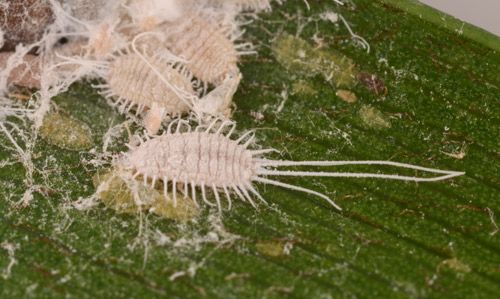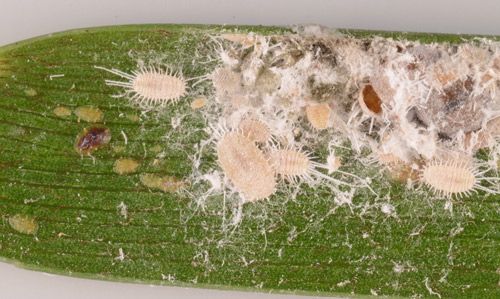Longtailed Mealybug Pseudococcus longispinus (Targioni Tozzetti) (Insecta: Hemiptera: Pseudococcidae)
The Featured Creatures collection provides in-depth profiles of insects, nematodes, arachnids and other organisms relevant to Florida. These profiles are intended for the use of interested laypersons with some knowledge of biology as well as academic audiences.
Introduction
The longtailed mealybug, Pseudococcus longispinus (Targioni Tozzetti), is a widely distributed pest that feeds on many economically important hosts, particularly tropical fruits and ornamentals. This mealybug gets its common name from the two long, waxy filaments protruding from the last abdominal segment of adult females (Figure 1). This characteristic helps distinguish it from other mealybugs that may feed on the same host plants, although these long filaments sometimes break off.

Credit: Morgan A. Byron, UF/IFAS
Distribution
The longtailed mealybug is found on every continent except Antarctica. It is a common greenhouse pest around the world but can also be found outdoors in warm climates (Tenbrink and Hara 2007).
Description and Life Cycle
Egg
There is no visible egg stage of the longtailed mealybug. Nymphs hatch immediately upon oviposition (laying), which has led some observers to mistakenly conclude that the female longtailed mealybug births live young (Goolsby 1994).
Nymphs
Female longtailed mealybug nymphs undergo three instars (growth stages) before reaching adulthood, whereas males undergo four (Goolsby 1994). When they first emerge from the egg, male and female first instars lack the diagnostic features of the adults and appear nearly identical. By the second instar, the nymphs have the white, waxy coating characteristic of mealybugs. Female nymphs increase greatly in size between the second and third instars and the long caudal filaments (the "tails" of the longtailed mealybug) have developed. The males feed only during the first and second instars; the third instar is sometimes called the prepupal stage (even though mealybugs are not holometabolous insects and do not undergo true metamorphosis) and lacks mouthparts (Goolsby 1994). Female nymphs feed throughout all instars.
Adults
The longtailed mealybug is a sexually dimorphic species, meaning the male and female do not look alike. Female longtailed mealybug adults resemble third instars, except they are less flattened in appearance due to the development of their reproductive organs (Goolsby 1994). Males of this species are more slender, darker in color, and as adults are winged. They are not as commonly collected as the female mealybugs, as they do not feed on the host plant.

Credit: Morgan A. Byron, UF/IFAS
Host Plants
The longtailed mealybug has a relatively wide host range that includes many economically important crops, such as avocado, citrus, grapes, pear, persimmon, and pineapple (Faber et al. 2007, Furness 1976, Dentener et al. 1997, Williams and Watson 1988). Valuable ornamental plants, especially those adapted to tropical and subtropical environments, are also hosts. These include species of cycads (Culbert 1995) and orchids (Kot et al. 2015, Ray and Hoy 2014). Plants kept inside homes or in greenhouses seem to be especially at risk for mealybug infestation, due to the relatively stable temperature and humidity of these environments (Blumberg and Van Driesche 2001).
Damage
Mealybugs and other insects with piercing-sucking mouthparts, like aphids, feed directly from the host plant vascular system. This food source is plentiful but somewhat dilute, meaning the insect must take in an abundance of plant sap to get adequate nutrition. Honeydew, a sugary substance periodically excreted from the insect's body, is a waste product of this feeding behavior. Honeydew itself is not harmful to the plant but can coat the leaves and nearby objects and encourage growth of a fungus known as sooty mold. Sooty mold, like honeydew, is not directly injurious to the plant, but it is unsightly, hard to remove, and can diminish the plant's photosynthetic capabilities. It also reduces or eliminates the economic value of fruits grown for fresh consumption and plants grown for ornamental value. Sometimes honeydew-producing insects are first noticed because of the presence of another insect species taking advantage of their sugary excretions. Colonies of longtailed mealybug have been observed being tended by white-footed ants, Technomyrmex difficilis Forel (Warner et al. 2002).
In addition to typical feeding damage, Pseudococcus longispinus, as well as several related mealybug species, is an efficient vector of Grapevine leafroll-associated virus 3 (GLRaV-3), a major causal agent of Grapevine leafroll disease (Douglas and Krüger 2008). The causal agents of Grapevine leafroll disease are distributed worldwide, and this disease reduces yield and quality of grapes used for juice, wine, and table consumption (Maree et al. 2013).
Management
Chemical control should be applied to the crawler (first instar) stage because they lack the outer waxy layer that protects older nymphs and adults and they are more mobile on the plant (Furness 1976). To control mealybug populations, excellent coverage is required for most foliar-applied contact insecticides. Insect growth regulators may be used but often take longer to kill the mealybugs. Systemic insecticides (pesticides that penetrate the leaf cuticle and circulate throughout the plant) are commonly used and can provide effective management of mealybugs. According to Ray and Hoy (2014) a mixture of 0.05% Silwet and 2% horticultural oil applied to infested orchid leaves (Phalaenopsis sp.) reduced longtailed mealybug survival to 18% 24 hours after application, suggesting that reduced-risk pesticides are also effective against these pests.
On avocado in southern California, the combined effort of two parasitoid wasps, Anarhopus sydneyensis Timberlake and Hungariela peregrina Compere, provides adequate control to reduce economic loss. Other species of parasitoid wasps that attack longtailed mealybug include Pseudaphycus angelicus (Howard), Tetracnemoidea syndneyensis (Timberlake), and Coccophagus gurneyi (Compere) (Blumberg and Van Driesche 2001). Beneficial insects with generalist feeding habits, like lady beetles and lacewings, will prey upon mealybugs, but may not provide effective control.
Selected References
Blumberg D, Van Driesche RG. 2001. Encapsulation rates of three encyrtid parasitoids by three mealybug species (Homoptera: Pseudococcidae) found commonly as pests in commercial greenhouses. Biological Control 22: 191–199.
Culbert DF. (1995). Florida coonties and Atala butterflies. MG347. Gainesville: University of Florida Institute of Food and Agricultural Sciences. (7 March 2022)
Dentener PR, Bennett KV, Hoy LE, Lewthwaite SE, Lester PJ, Maindonald JH, Connolly PG. 1997. Postharvest disinfestation of lightbrown apple moth and longtailed mealybug on persimmons using heat and cold. Postharvest Biology and Technology 12: 255–264.
Douglas N, Krüger K. 2008. Transmission efficiency of Grapevine leafroll-associated virus 3 (GLRaV-3) by the mealybugs Planococcus ficus and Pseudococcus longispinus (Hemiptera: Pseudococcidae). European Journal of Plant Pathology 122: 207-212.
Faber BA, Morse JG, Hoddle MS. (2007). UC IPM pest management guidelines: Avocado. UC ANR Publication 3436. University of California Agriculture and Natural Resources. (5 September 2019)
Furness GO. 1976. The dispersal, age-structure and natural enemies of the long-tailed mealybug, Pseudococcus longispinus (Targioni-Tozzetti), in relation to sampling and control. Australian Journal of Zoology 24: 237–247.
Goolsby JA, III. 1994. Biological control of longtailed mealybug, Pseudococcus longispinus (Targioni-Tozzetti) (Homoptera: Pseudococcidae) in the interior plantscape. Dissertation, Texas A&M University. (5 September 2019)
Kot I, Kmiec K, Gorska-Drabik E, Golan K, Rubinowska K, Lagowska B. 2015. The effect of mealybug Pseudococcus longispinus (Targioni Tozzetti) infestation of different density on physiological responses of Phalaenopsis × hybridum 'Innocence'. Bulletin of Entomological Research 105: 373–380. (5 September 2019)
Maree HJ, Almeida RPP, Bester R, Chooi KM, Cohen D, Dolja VV, Fuchs MF, Golino DA, Jooste AEC, Martelli GP, Naidu RA, Rowhani A, Saldarelli P, Burger JT. 2013. Grapevine leafroll-associated virus 3. Frontiers in Microbiology 4: 1–21. (7 March 2022)
Ray HA, Hoy MA. 2014. Effects of reduced-risk insecticides on three orchid pests and two predacious natural enemies. Florida Entomologist 97: 972-978.
Saccaggi DL, Kruger K, Pietersen G. 2008. A multiplex PCR assay for the simultaneous identification of three mealybug species (Hemiptera: Pseudococcidae). Bulletin of Entomological Research 98: 27-33.
Tenbrink VL, Hara AH. (2007). Pseudococcus longispinus (Targioni-Tozzetti), longtailed mealybug. Crop Knowledge Master, University of Hawaii. (5 September 2019)
Warner J, Scheffrahn RH, Cabrera B. (2002). White-footed ant, Technomyrmex difficilis Forel. EENY-273. Gainesville: University of Florida Institute of Food and Agricultural Sciences. (5 September 2019)
Waterworth RA, Wright IM, Millar JG. 2011. Reproductive biology of three cosmopolitan mealybug (Hemiptera: Pseudococcidae) species, Pseudococcus longispinus, Pseudococcus viburni, and Planococcus ficus. Annals of the Entomological Society of America 104: 249–260.



